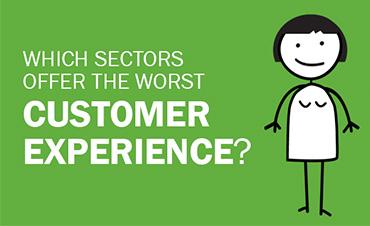Which sectors offer the worst customer experience?

While all industries need to ensure they are delivering an excellent customer experience, some seem to be intrinsically better at it than others. This concept is backed up by recent research carried out by service design consultancy Engine. Its survey found that consumers rated the public transport (including train operators), utility, insurance and broadband sectors, as worst for customer experience and service.
At the other end of the league table, retail was named as providing the best customer experience of all sectors (by 38% of consumers), followed by hotel and hospitality, and food service/restaurants.
These findings provide an important lesson. Consumer expectations are always rising, and they will judge every sector against the best. They demand the same excellent customer experience when dealing with a utility or bank as when buying a book or DVD online. Therefore every brand, irrespective of sector, needs to benchmark themselves against the best and continuously innovate to win and retain customers.
What makes customer experience difficult?
At the same time, the factors that impact how your customer experience is viewed – and how easy or difficult it is to deliver it, do vary from sector to sector. There are at least four variables involved:
1. Competition and choice
Clearly, the easier it is for a consumer to switch from your company, the better your customer experience needs to be if you are to win their loyalty. So sectors where there is a lot of choice, such as retail, restaurants, and airlines, have invested heavily in customer experience. They know that they may not get a second chance if they fail to meet the high levels that consumers set. Additionally, in sectors such as retail different companies may well be selling a similar (or even identical) product, meaning that they can either choose to differentiate on price (which can hit profitability) or service.
At the other end of the spectrum, passengers often have little choice about public transport options, short of switching to driving, cycling or walking. This doesn’t mean that companies should invest less in the customer experience, but it does mean that consumer frustrations will build if they receive sub-optimal service, as they know that there is little they can do to change things.
2. Complexity
Consumers value simplicity and a seamless experience, whatever channel they choose. However, achieving this can be a lot harder in some sectors than others. For example, going to a restaurant for a meal is a relatively straightforward transaction, allowing companies to focus on making ongoing improvements to an established process. In contrast, telecoms companies, such as wireless providers, manage networks with thousands of different pieces of equipment, some of which they own, and some of which can be run by other people. The number of variables involved in delivering broadband is much greater, and if it does go wrong it can be correspondingly difficult to track down the problem.
3. Visibility
Whether you are supplying a product or service can also impact how your customer service is judged, particularly around how visible it is. A service such as a hotel room or a flight comes with physical attributes such as a comfortable bed, extra legroom or entertainment systems. In contrast, the gas or electricity provided by a utility supplier, or the cover provided by an insurer are invisible to the customer. Consumers may therefore be more willing to judge customer service as poor, as it is the only contact they have with brands in these industries.
4. Impact of things going wrong
Consumers also judge companies by how poor service impacts their lives. This means they are likely to be particularly harsh on issues that cause them major inconvenience – such as cancelled trains, no heat or being unable to stream Netflix. In contrast, a grocery store running out of their brand has a lesser effect on their lives. Consequently, the more important the service a company provides, the more complaints they will get if it goes wrong.
Every company needs to offer the highest levels of customer service, but it is important to recognize that the factors above can impact how easy it is to solve issues and, equally importantly, how consumers view your service. Therefore, those companies in markets where consumer expectations are higher need to work even harder if they are to succeed in delivering the experience that customers demand.







Comments